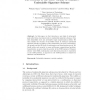Free Online Productivity Tools
i2Speak
i2Symbol
i2OCR
iTex2Img
iWeb2Print
iWeb2Shot
i2Type
iPdf2Split
iPdf2Merge
i2Bopomofo
i2Arabic
i2Style
i2Image
i2PDF
iLatex2Rtf
Sci2ools
PKC
2005
Springer
2005
Springer
The Security of the FDH Variant of Chaum's Undeniable Signature Scheme
In this paper, we first introduce a new kind of adversarial goal called forge-and-impersonate in undeniable signature schemes. Note that forgeability does not necessarily imply impersonation ability. We then classify the security of the FDH variant of Chaum’s undeniable signature scheme according to three dimensions, the goal of adversaries, the attacks and the ZK level of confirmation and disavowal protocols. We finally relate each security to some well-known computational problem. In particular, we prove that the security of the FDH variant of Chaum’s scheme with NIZK confirmation and disavowal protocols is equivalent to the CDH problem, as opposed to the GDH problem as claimed by Okamoto and Pointcheval.
Chaum’s Undeniable Signature | Cryptography | Disavowal Protocols | PKC 2005 | Undeniable Signature Scheme |
| Added | 28 Jun 2010 |
| Updated | 28 Jun 2010 |
| Type | Conference |
| Year | 2005 |
| Where | PKC |
| Authors | Wakaha Ogata, Kaoru Kurosawa, Swee-Huay Heng |
Comments (0)

